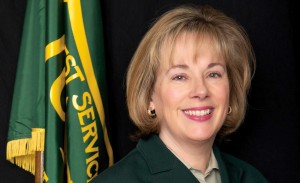Journey started at State
Following the trail to become a wildlife biologist meant taking a two-year journey through graduate school for two State alums
For Beth Giron ’83 and Grey Pendleton ’84, it turned into the journey that sent them to the altar of holy matrimony and 33 years worth of journeys afterward from coast to coast.
Today, Beth Pendleton is the U.S. Forest Service’s Alaska region supervisor. Grey Pendleton is a biometrician with the Alaska  Department of Fish and Game. Both are in Juneau. She oversees 22 million acres of national forests, 650 permanent employees and a $100 million budget. He is the math man when it comes to planning and analyzing wildlife studies.
Department of Fish and Game. Both are in Juneau. She oversees 22 million acres of national forests, 650 permanent employees and a $100 million budget. He is the math man when it comes to planning and analyzing wildlife studies.
Both entered graduate school at State in late summer 1980, coming from opposite regions of the United States.
Grey Pendleton, a native of Boulder City, Nevada, had earned a degree in zoology from Brigham Young. Beth Pendleton, a native of Virginia who lived in several New England states, had a degree in wildlife biology from the University of Vermont. Both came to SDSU to work on a wetland research project.
One thing the project proved is that birds of a feather really do stick together. They were among three couples on the research team to marry.
More schooling
Giron and Pendleton started dating shortly after their arrival and were married in March 1982. Beth graduated in 1983. Grey in 1984. They found it much easier to find a life partner than to find a job.
“The job market wasn’t all that great. There had been a lot of big cutbacks, especially in the state and federal areas,†Beth said.
So they continued on the path they had been on—graduate school—this time at the University of Wyoming.
At Wyoming, Grey earned a master’s in statistics in 1985. Beth’s master of journalism degree wasn’t awarded until 1987, but by  1985 she was already using those skills and the Pendletons had added a son, Andrew, to their family.
1985 she was already using those skills and the Pendletons had added a son, Andrew, to their family.
Wildlife work in D.C.
The Pendletons left Wyoming for Washington, D.C., where she was an information specialist for the National Wildlife Federation and he was a statistician with the U.S. Fish and Wildlife Service. Grey held that post until 1996, when he took his current job studying the counts of sea lions, seals, waterfowl and other wildlife.
Beth’s career leap came in 1991, when she became a marketing specialist with the U.S. Forest Service in Washington, D.C. She had been doing technical editing and arranging symposiums for the National Wildlife Federation, but cutbacks in their research projects made her job tenuous. The Forest Service job in the Wildlife, Fish and Rare Plants staff created challenges for which Beth said she was looking.
It also started her on a path to a position she couldn’t have imagined when in graduate school. By 1995 she was in Juneau as team leader on a revision of the land and resource management plan for the 17-million acre Tongass National Forest. She held several other posts, including Alaska director for recreation, lands and minerals and deputy regional forester in California, before being promoted to her current job in March 2010. As senior administrator for the Alaska region, she carries out a conservation plan that regulates the heartbeat of the region.
Making sense of numbers
While Beth’s workday is dominated by budgets, personnel, conferences and reports, Grey said as a biometrician, “I sit in front of a computer a lot. I help research biologists plan and conduct their studies—study planning, study implementation and data analysis.†He spends two to four weeks a year in the field.
“I get to go out to some amazing places,†he said.
Dave Graves






